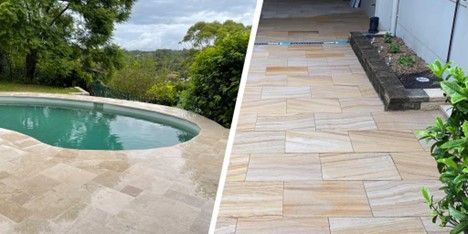One of the most talked-about natural stones while discussing recent developments in the building sector is Travertine. Because of its attractive earth-tone hues and fibrous, organic texture, it is one of the most often used building materials. Although it has historically been widely utilised in architecture and art, the majority of Travertine pavers and tiles are currently shipped from Turkey, Iran, Mexico and Peru.
In Australia, both homeowners and landscapers appreciate using Travertine pavers and tiles, which come in a variety of earth tones like tans, browns, rust and beige. Out of all of them, the most trending colour is Ivory Travertine tiles. While these Travertine stones are fairly durable and require less maintenance than some other types of natural stone, they are also quite heavy and require regular surface sealing. Not every place is appropriate for it. However, a well-installed Travertine floor might provide interior spaces with a touch of the splendour of the mountains.
Read more!
The three types of Travertine installation
Three distinct kinds exist. We can help you choose the installation technique that will be most effective for you.
- Direct lay: Using certain adhesives, the Ivory Travertine floor tiles are just laid on the slab in this method.
- Wet lay: After preparing a sand and cement mixture, the installer will apply adhesive to the concrete slab and the backs of the Travertine floor tiles. Next, the stone is appropriately tapped into the combination of wet sand and cement.
- Screeding: In this procedure, the concrete slab is covered with a layer of sand and cement, which is then allowed to dry. After it has dried, adhesive is used to hold the Ivory Travertine tile in place.
Step By Step Process of Installing Ivory Travertine Tiles
-
Preparing The Floor and Surface
One of the most important stages in simplifying the rest of the work is floor preparation. It’s also essential for avoiding more floor cracks.
#1: Remove any adhesive or glue that was used to put in the present flooring.
#2: To create a level surface for your Ivory Travertine tile, clean the concrete portion of your floor and search for any elevated areas that may need to be ground down.
#3: If you’re installing Ivory Travertine tiles over a wood subfloor, underlayment is required. The most common size is a 1/4″ or 1/2″ cement board. Follow the manufacturer’s directions for installation. This usually means nailing or screwing the cement board to the OSB flooring on top of a layer of thin-set mortar.
#4: Prior to laying wall tile, make sure the surface is level and clean. Plasterboard can be covered with tile in places like kitchen backsplashes. But in places like shower or tub surrounds, you have to build cement board and cover it with a waterproof coating.
-
Installing your Ivory Travertine tiles
This is where you plan the tile layout and decide where to start in a large area (larger than a bathroom).
#1: Use the same steps as in the previous part to determine the halfway and modify the Ivory Travertine tile. This time, though, you have to do it both width-wise and longitudinally. This will provide you with a base from which to work.
#2: Use a framing square to make sure the crossing lines are square.
#3: Follow the manufacturer’s instructions for preparing the thin-set. (The consistency should be similar to mashed potatoes). Use white thin-set for Travertine. By seeping into the stone, a dark thin-set can alter its hue.
#4: Using a 1/4″ notched trowel (or a bigger trowel for large format stone tiles and uneven flooring), spread the mortar across the floor. Maintain a steady angle with the trowel to ensure equal grout distribution.
#5: Press the tile firmly into the mortar after positioning it there. (A soft rubber mallet can also be used.)
#6: The first five Ivory Travertine tiles are the most important. Test their squareness and levelness by arranging a few in a diagonal pattern.
#7: Remember to use tile spacers in the joints.
#8: Use a damp sponge to remove any remaining mortar from the tile surface or the joints.
#9: Cut the pieces for the edges with a tile saw or tile snap cutter.
-
Applying Grout, Cleaning and Finishing
As instructed by the manufacturer, first mix the grout into a paste that resembles peanut butter. Next, use a grout float to distribute the mixture into the joints. As you work, use the float to scrape off as much excess grout as you can from the tile surface.
#1: Use a large sponge and water to clean the surface of the Ivory Travertine tiles. Kindly be cautious not to smudge the grout lines.
#2: You’ll probably require fresh water more than once.
#3: Come back a day later and use a dry towel or sponge to remove any remaining grout haze.
#4: To protect surfaces from possible stains, use a sealer.
Conclusion
Lastly, adding rustic beauty and organic elegance to your living spaces may be achieved via the use of Ivory Travertine tiles. Originating in Turkey, Iran, Mexico and Peru, Travertine is a stone that is utilised extensively. Due to its range of earth-tone tones, Australian landscapers and homeowners love it. So, what are you waiting for? Get started with all your projects with Ivory Travertine tiles from Stone Depot.



















